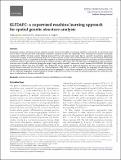Files in this item
KLFDAPC : a supervised machine learning approach for spatial genetic structure analysis
Item metadata
| dc.contributor.author | Qin, Xinghu | |
| dc.contributor.author | Chiang, Charleston W K | |
| dc.contributor.author | Gaggiotti, Oscar E | |
| dc.date.accessioned | 2022-06-17T07:30:09Z | |
| dc.date.available | 2022-06-17T07:30:09Z | |
| dc.date.issued | 2022-07-01 | |
| dc.identifier | 280015769 | |
| dc.identifier | 37f47524-f34c-48d1-8d65-b6931aeced17 | |
| dc.identifier | 35649387 | |
| dc.identifier | 85134632664 | |
| dc.identifier | 000804257200001 | |
| dc.identifier.citation | Qin , X , Chiang , C W K & Gaggiotti , O E 2022 , ' KLFDAPC : a supervised machine learning approach for spatial genetic structure analysis ' , Briefings in Bioinformatics , vol. 23 , no. 4 , bbac202 . https://doi.org/10.1093/bib/bbac202 | en |
| dc.identifier.issn | 1467-5463 | |
| dc.identifier.other | ORCID: /0000-0003-1827-1493/work/114336023 | |
| dc.identifier.uri | https://hdl.handle.net/10023/25543 | |
| dc.description | Funding: CSC-University of St Andrews Joint Scholarship (to X.Q.); International Postdoctoral Exchange Fellowship Program (Talent-Introduction Program) from China Postdoc Council (to X.Q.); National Institute of General Medical Sciences (NIGMS) of the National Institute of Health (grant R35GM142783 to C.W.K.C.). Part of the computation for this work is supported by USC’s Center for Advanced Research Computing (https://carc.usc.edu). | en |
| dc.description.abstract | Geographic patterns of human genetic variation provide important insights into human evolution and disease. A commonly used tool to detect and describe them is principal component analysis (PCA) or the supervised linear discriminant analysis of principal components (DAPC). However, genetic features produced from both approaches could fail to correctly characterize population structure for complex scenarios involving admixture. In this study, we introduce Kernel Local Fisher Discriminant Analysis of Principal Components (KLFDAPC), a supervised non-linear approach for inferring individual geographic genetic structure that could rectify the limitations of these approaches by preserving the multimodal space of samples. We tested the power of KLFDAPC to infer population structure and to predict individual geographic origin using neural networks. Simulation results showed that KLFDAPC has higher discriminatory power than PCA and DAPC. The application of our method to empirical European and East Asian genome-wide genetic datasets indicated that the first two reduced features of KLFDAPC correctly recapitulated the geography of individuals and significantly improved the accuracy of predicting individual geographic origin when compared to PCA and DAPC. Therefore, KLFDAPC can be useful for geographic ancestry inference, design of genome scans and correction for spatial stratification in GWAS that link genes to adaptation or disease susceptibility. | |
| dc.format.extent | 16 | |
| dc.format.extent | 2058603 | |
| dc.language.iso | eng | |
| dc.relation.ispartof | Briefings in Bioinformatics | en |
| dc.subject | Machine learning | en |
| dc.subject | Population structure | en |
| dc.subject | Individual geographic origin | en |
| dc.subject | QA75 Electronic computers. Computer science | en |
| dc.subject | DAS | en |
| dc.subject | SDG 3 - Good Health and Well-being | en |
| dc.subject | MCC | en |
| dc.subject.lcc | QA75 | en |
| dc.title | KLFDAPC : a supervised machine learning approach for spatial genetic structure analysis | en |
| dc.type | Journal article | en |
| dc.contributor.institution | University of St Andrews. School of Biology | en |
| dc.contributor.institution | University of St Andrews. Centre for Biological Diversity | en |
| dc.contributor.institution | University of St Andrews. Scottish Oceans Institute | en |
| dc.contributor.institution | University of St Andrews. St Andrews Bioinformatics Unit | en |
| dc.contributor.institution | University of St Andrews. Marine Alliance for Science & Technology Scotland | en |
| dc.identifier.doi | 10.1093/bib/bbac202 | |
| dc.description.status | Peer reviewed | en |
This item appears in the following Collection(s)
Items in the St Andrews Research Repository are protected by copyright, with all rights reserved, unless otherwise indicated.

